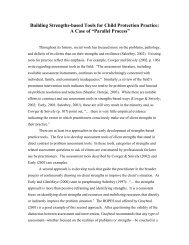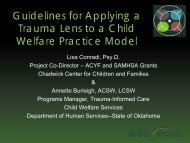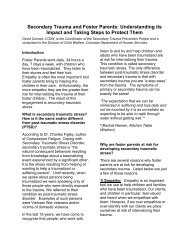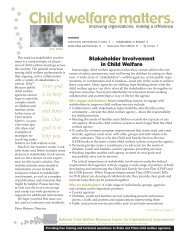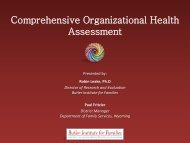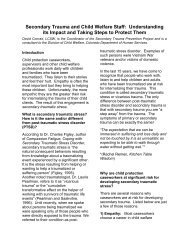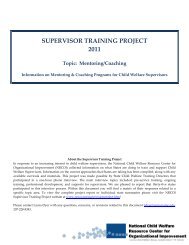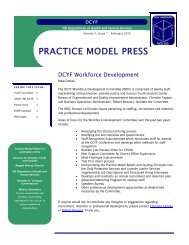Building a Model and Framework for Child Welfare Supervision
Building a Model and Framework for Child Welfare Supervision
Building a Model and Framework for Child Welfare Supervision
You also want an ePaper? Increase the reach of your titles
YUMPU automatically turns print PDFs into web optimized ePapers that Google loves.
The project team contacted potential interviewees by email or telephone <strong>and</strong> made appointments<br />
with those who agreed to be interviewed. In advance of the appointment, the interview protocol was<br />
emailed to them. Interviews were conducted by phone, with at least two project team members<br />
attending; one conducted the interview <strong>and</strong> the other took notes. Interview length ranged from 30<br />
minutes to over an hour. Respondents were assured that their comments would remain anonymous<br />
<strong>and</strong> that interview excerpts included in project products would not be attributed by respondent’s<br />
name or agency. One respondent chose to complete the interview protocol <strong>and</strong> return it via email<br />
rather than complete the interview over the phone.<br />
Once an interview was completed, we inquired whether it would be possible to interview the<br />
respondent's administrator, supervisor, <strong>and</strong>/or caseworker in order to complete the triad. Due to the<br />
unpredictable nature of child welfare staff activities, it was difficult to complete interviews as<br />
scheduled. Nineteen (19) interviews were completed: nine administrators, six supervisors, <strong>and</strong> four<br />
caseworkers.<br />
Data analysis<br />
The interview data were compiled <strong>and</strong> analyzed by the project team. A content analysis was<br />
conducted by each of the three project team members; themes identified in the data <strong>and</strong> responses to<br />
specific protocol questions were compared. Data were reviewed in the aggregate as well as by<br />
interviewees’ agency job positions to identify similarities <strong>and</strong> differences between supervisors,<br />
administrators <strong>and</strong> caseworkers. Descriptive statistics of key in<strong>for</strong>mants’ ratings regarding the<br />
importance of child welfare supervisors’ job responsibilities (i.e. most important, important, not<br />
important, not applicable/not aware) were also analyzed <strong>and</strong> compared to determine the ways in<br />
which these were similar <strong>and</strong> different when findings were grouped by agency position. When these<br />
analyses were completed, the findings were reviewed with working group members, who provided<br />
feedback regarding the consistency of the findings with their observations in the field <strong>and</strong> also<br />
raised questions <strong>for</strong> further data analysis.<br />
Interviews with subject matter experts<br />
Following data analysis, we reviewed our findings with three subject matter experts who have<br />
worked extensively in the area of child welfare supervision <strong>and</strong> have completed demonstration<br />
projects addressing effective supervision. These experts, Crystal Collins-Camargo, Ph.D. of the<br />
University of Kentucky School of Social Work, <strong>and</strong> Steve Preister, Ph.D. <strong>and</strong> Joe Murray of the<br />
National <strong>Child</strong> <strong>Welfare</strong> Resource Center <strong>for</strong> Organizational Improvement, were either members of<br />
the advisory committee or were identified by members knowledgeable of their work. The findings<br />
were shared <strong>and</strong> reviewed with the subject matter experts in order to seek their perspectives about<br />
the ways in which the findings were consistent or inconsistent with their own observations in the<br />
field. All project team members attended each subject matter expert interview, <strong>and</strong> the notes from<br />
the interview were transcribed. These experts also provided written materials on their demonstration<br />
projects.<br />
46




